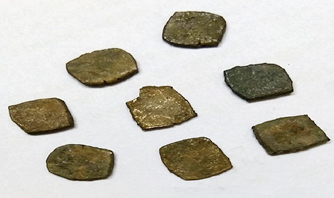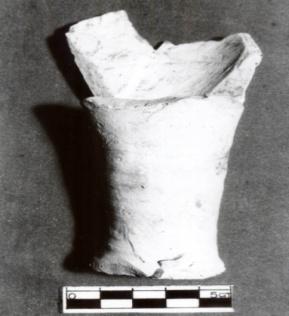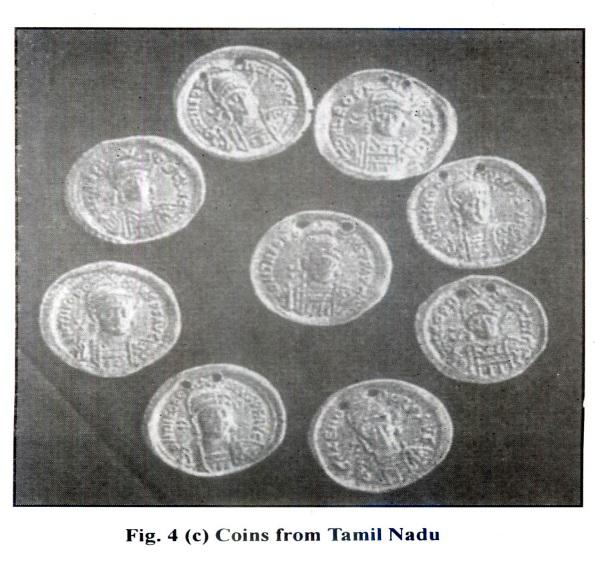- SATVAHANAS

Goa might or might not have been part of the vast Maurya Empire1 which controlled the whole of India up to the southern boundary of Karnataka from the third century BC. In the second century BC, the Satvahanas had taken over the Southern peninsula of India from the Mauryas and ruled over it for almost 300 years till 203 AD. A few coins of the Satvahana period have been retrieved from the petrified mud in the Pilar tank. The ASI archaeologists have also unearthed a number of those coins from Chandrapura (Chandor –Goa). Satkarni, the third king of this dynasty, is said to have extended his sway over Western India, including the Konkan of which Goa is part. His reign lasted for half a century. After him, for a century, the Shakas challenged the Satvahana supremacy but Gautamiputra Satkarni restored their fallen fortune by defeating the Shakas, and ruled over the empire from 100 to 130 AD.
His son’s Nashik inscription credits him with the supremacy over the entire southern peninsular India bounded by the three seas. The Satvahana power came to an end with the death of Yagnashrii Satkarni in 203 AD.
However, side by side, during the 2nd century, some Kshatrapas from Gujarat and Chutus from Karnataka, are said to have held sway over some parts of North and South Goa respectively. So also in the 3rd century, the Abhiras are said to have controlled some other parts of Goa.
- MANTRAZAR, A GOVERNOR OF GOA?
Did the Satvahanas have a Governor in Goa? It is but natural that in such a well-organized Satvahana Empire, that controlled the whole of South India, there were Governors at the helm of each of their Provinces. Regarding Goa, a port with foreign contacts, there had to be one as such. This is confirmed by documents available in Portuguese writings. According to the Jesuit Francisco Souza, a metal plate bearing an inscription, in Kannadi characters, was shown to Portuguese officials in the city of Goa (presently Old Goa), with its translation in Portuguese in the year 1532 AD2. The metal plate speaks of Mantrazar, a Governor of Goa and his son and daughter-in-law, who confessed the truth of the existence of only one God and professed their faith in the mysteries of the Trinity and the Incarnation, thanks to the teachings of St Thomas the Apostle3. Leonardo Paes also gives the same information, quotingFriar Francisco Negrao4 and Friar Diogo do Rosario. He also says that the Vijayanagar Rayas claimed that Mantrazar was their very remote ancestor5. About the coming of St. Thomas and his apostolate in India, including Goa, please see the next Chapter (Chapter 3, section 3).
- ROMAN CONTACTS

Among the artefacts found in Pilar, there is a piece of a Roman Amphora and a small piece of black Roman glass belonging to the first and second centuries AD which testify to the fact that the Satvahanas had trade relations with Rome6 through the Gopakapattana or Goa-Velha harbour. These were found at a depth of 18 feet at the bottom of the Pilar tank, mentioned in the Introduction. R. M. Cimino comments in her book, “The Amphora for transport, though pertaining to a class of material lacking in intrinsic artistic value, constitute one of the most valid, instruments for historical investigation, being the type of containers most diffused among those used in ancient times for transport and preservation of numerous liquid and solid products in almost exclusively food stuff, wine, oil, vinegar, honey, olives, fruits etc.7 R. M Cimino’s book also gives a picture showing a collection of different amphorae as given in figure 7 (b).
It is a well-known fact that Roman ships used to trade with India, through Arabia right from the beginning of the first century AD, if not earlier. With the occupation of Egypt by the Romans in 30 BC, the way was opened for

Roman ships to have direct trade links with Indian ports. V. T. Gune has reported that at the reconstruction of the Brahmavatara temple in Mapusa, a similar cup shaped object was discovered in the 1970’s8. The Sea route from Arabia to Kerala and Tamilnadu passes through the West Coast of India. Gopakapattana that lies on this route was surely, therefore, a port of call for Roman ships.

Hoards of Roman coins of Caesar Augustus and other Roman Emperors have also been unearthed from Kerala, Tamilnadu and other parts of South India. Here is a Xerox copy of a hoard of Roman coins found at Nathampatti in Virudhunagar district, as reported by the daily THE HINDU on 15th May 1998 (figure 7(c).

Figure 7 (d) Roman Coins from the Pilar Tank
These trade contacts must have continued with Gopakapattana even after the eclipse of the Satvahanas, for the Pilar tank too has yielded three coins of a later period: one of Emperor Diocletian, who ruled from 284 to 305 AD and two of the Emperor Constantine, the Great who ruled from 312 to 337 AD from Constantinople and Rome. One side of each coin shows the bust of the respective Emperor with inscription, as shown below each set in figure 7d, and the other side, shown alongside of each, has some inscription, figures and words perhaps exalting the feats of that Emperor. The Roman Empire of the West, ruled from Rome, came to an end in 476 AD.
POST-SATVAHANA GOA
Continuing Goa’s history in the times after the eclipse of the Satvahanas, some parts of Goa are said to have also come under the sway of the Nagas in the 4th century; the Traikotakas in the 5th century; and in the 6th century under the local Bhojas from their capital at Chandrapura; while Bicholim and Divar were under the Kaikeyas; in the seventh century another local dynasty of the Konkan Mauryas eclipsed the Bhojas. These dynasties or rulers left their own impact in the places they controlled.9 However, we do not find any vestiges of these rulers in Pilar. However, we do not find any vestiges of these rulers in Pilar.
1 ARS Dhume, The Cultural History … op cit. p 185
2 Sousa, Francisco de, Oriente Conquistado a Jesu Chrsito…Lisboa, 1710, p. 24
3 Manoel de Faria & Souza in Asia Portugueza, tom. I. p. 2. cap. 5 § 1.
4 Frei Francisco Negrao, Tratado II dos Reys da India, p I. lib. 1. arg. 13.
5 Paes, Leonardo, Promptuario das diffiniçoes Indicas… trat. V, cap. IV, pp. 232, 233.
6 Nand Kumar Kamat, “The Kadamba Capital of Gopaka (Goa-Velha) and the story of Goddess Chamunda”, Souvenir of 65th Anniversary of Chamunda – Piligao, ed. Ramkrishna Zuwarkar, Ch. ”The First Rulers of Gopakapattana”
7 R. M. Cimino, Ancient Rome and India, Manshhiram, Manoharlal Publishers for Italian Embassy Cultural Centre, New Delhi, 1994, p 154.
8 V.T. Gune, Maritime Traditions of Goa’s Commerce, pp 43-44
9 George Mark Moraes, Kadamba Kula op cit. pp.125-126; Gerald A Pereira op cit. pp 15-27.
